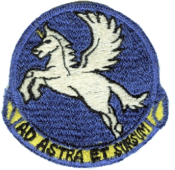817th Expeditionary Airlift Squadron
| 817th Expeditionary Airlift Squadron | |
|---|---|
|
Members of the 8th Airlift Squadron are welcomed home as they return from a 60-day deployment to Southwest Asia, April 5, 2013, at Joint Base Lewis-McChord, Washington. The Airmen were deployed as the 817th Expeditionary Airlift Squadron in support of Operation Enduring Freedom. | |
| Active | 1943-1966; 2002-2014 |
| Country |
|
| Branch |
|
| Engagements |
|
| Decorations |
|
| Insignia | |
| Emblem of the 817th Expeditionary Airlift Squadron |
 |
The 817th Expeditionary Airlift Squadron (817 EAS) is a provisional United States Air Force unit. It is currently engaged in combat operations in Southwest Asia. It was inactivated in 2014, however it can be re-activated at any time.
During World War II as the 817th Bombardment Squadron, it was one of the last B-17 Flying Fortress heavy bomber squadrons deployed to Southern Italy as part of the Fifteenth Air Force 483d Bombardment Group in March 1944.
Mission
The 817 EAS was equipped with McDonnell Douglas C-17 Globemaster III transports and supports Coalition forces engaging in combat operations as part of Operation Enduring Freedom and Operation Iraqi Freedom, and also operates in the Horn of Africa.
The mission of the 817h EAS is to provide global strategic airlift, airdrop, aeromedical evacuation and humanitarian relief, to create an air bridge for personnel, equipment and supplies throughout their assigned areas of responsibility.
History
Established in late 1943 as a Boeing B-17 Flying Fortress heavy bombardment squadron, trained under Third Air Force in Florida. Was deployed to the Mediterranean Theater of Operations (MTO), being assigned to Fifteenth Air Force in Southern Italy. Engaged in long-range strategic bombardment of enemy military, industrial and transport targets, including oil refineries and production oilfields in Italy, France, southern Germany. Austria and the Balkans. Continued strategic bombardment until German capitulation in May 1945.

After V-E Day, was assigned to Air Transport Command (ATC) Green Project which was the movement of troops from Pisa Airfield staging area in Morocco. B-17s were dearmed with flooring and seats for 25 passengers installed. Crew consisted of Pilot, Co-Pilot, Navigator and Flight Engineer. Carried passengers from Pisa to Port Lyautey Airfield, French Morocco where ATC transports moved them across the Atlantic or to Dakar for movement via South Atlantic Transport Route. Inactivated in Italy in September 1945.
Reactivated by Far East Air Forces in 1952 in Japan as a C-119 Troop Carrier squadron. Engaged in combat operations in South Korea transporting personnel and supplies to front-line units, under hazardous conditions. Also evacuated wounded personnel to hospital facilities in South Korea and Japan. Remained in Japan after the 1953 Armistice, providing intra-theater transport within Japan, South Korea and Okinawa.
Moved to Okinawa in 1958, re-equipped with C-130A Hercules aircraft. Continued intra-theater transport operations, also flying to locations in the Philippines, Thailand and Indochina, supporting United States civilian and military personnel assigned to the region. As the United States increased its combat presence in Indochina in the early 1960s, made frequent flights to airfields in South Vietnam and to locations within the country. As in South Korea, the flights within South Vietnam were extremely hazardous as the squadron operated within combat areas and frequently were under fire from communist forces during takeoff, landing and ground operations. Inactivated in 1970 as part of the drawdown of US forces in Southeast Asia.
Reactivated in 2002 as a C-17 Globemaster III squadron as part of the Global War on Terrorism. Provides intra-theater transport within Southwest Asia and other locations as directed in support of units engaged in combat operations.
Lineage


- Constituted as the 817th Bombardment Squadron (Heavy) on 14 September 1943
- Activated on 20 September 1943
- Re-designated 817th Bombardment Squadron, Heavy c. September 1944
- Inactivated on 25 September 1945
- Re-designated 817th Troop Carrier Squadron, Medium on 15 November 1952
- Activated on 1 January 1953
- Re-designated 817th Troop Carrier Squadron on 8 December 1965
- Re-designated 817th Tactical Airlift Squadron on 1 August 1967
- Inactivated on 15 June 1970
- Re-designated 817th Expeditionary Airlift Squadron and converted to provisional status, on 12 June 2002
- Inactivated on 1 April 2014
Assignments
- 483d Bombardment Group, 20 September 1943 – 25 September 1945
- 483d Troop Carrier Group, 1 January 1953
- 483d Troop Carrier Wing, 8 December 1958
- 315th Air Division, 25 June 1960 – 8 August 1966[1] (attached to 6315th Operations Group)
- 374th Troop Carrier (later, 374th Tactical Airlift) Wing, 8 August 1966 – 15 June 1970
- Air Mobility Command to activate or inactivate at any time after 12 June 2002.
Stations
- Ephrata Army Air Base, Washington, 20 September 1943
- MacDill Field, Florida, 7 November 1943 – 2 March 1944
- Sterparone Airfield, Italy, 9 April 1944
- Pisa Airfield, Italy, 15 May 1945 - 25 September 1945
- Ashiya Air Base, Japan, 1 January 1953
- Naha Air Base, Okinawa, 25 June 1960 - 15 June 1970.
- Southwest Asia, 2002-2014
Aircraft
- B-17 Flying Fortress, 1943–1945
- C-119 Flying Boxcar, 1953–1959
- C-130 Hercules, 1958–1970
- C-17 Globemaster III, 2002-2014
See also
References
Notes
- ↑ "Factsheet 315 Air Division". Air Force Historical Research Agency. 2007-12-10. Archived from the original on October 30, 2012. Retrieved February 24, 2014.
Bibliography
![]() This article incorporates public domain material from the Air Force Historical Research Agency website http://www.afhra.af.mil/.
This article incorporates public domain material from the Air Force Historical Research Agency website http://www.afhra.af.mil/.
- Maurer, Maurer, ed. (1982) [1969]. Combat Squadrons of the Air Force, World War II (PDF) (reprint ed.). Washington, DC: Office of Air Force History. ISBN 0-405-12194-6. LCCN 70605402. OCLC 72556.
